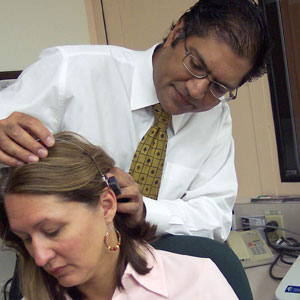 |
Dr. Manohar Bance is team leader of the Bone Conduction Hearing Technologies Project. The project seeks to develop non-invasive hearing aids and audio devices that use skull vibrations to create sound. It has recently been awarded a $2.6 million grant through the Atlantic Innovation Fund of the Atlantic Canada Opportunities Agency (ACOA).
Bone conduction technology à using skull vibrations instead of sound waves to stimulate the inner ear à has developed over the past decade to aid rehabilitation for the hearing impaired. ÃFor many patients, it is the only option they have to hear,â says Dr. Bance, who is also a staff surgeon with Capital Health.
Existing technologies are costly and usually involve implanting a titanium device directly into the skull. Dr. BanceÃs project will develop bone conduction devices that can be worn without surgery and would leave the ear canal open, allowing listeners to still hear environmental sounds while using the devices. This Ãprivate listeningâ could prove revolutionary in a number of crucial fields.
ÃWe are hoping to apply this science to technologies such as hearing aids, telecommunications, entertainment, securityÃany industry that works in the human experience of sound,â says Dr. Bance. ÃPeople are already experimenting with bone conduction in all sorts of industries, but they are often big, clunky devices that use a steel band to put pressure on the skull. The key is to find a transducer that is comfortable to wear and sounds professional.â
Dr. BanceÃs team includes representatives from HÂþ», Capital Health, the University of New Brunswick and Defence Research and Development Canada. They are also partnering with Bone Anchored Solutions, a Swedish company. The project, which will last five years at an estimated total cost $4 million, hopes to have a prototype within three years.
The project hopes to make long-term investments in the sustainable economy of the Atlantic region by generating new intellectual property and products and attracting and employing highly skilled personnel. It also hopes to use revenues from any product licenses to grow the regionÃs research and development capacity.
ÃThis is hopefully the nucleus of a whole hearing sciences cluster in this region,â says Dr. Bance. ÃThere are a lot of marketplaces out there for sound.â
The Bone Conduction Hearing Technologies Project team:
Dr. Manohar Bance, clinician surgeon/scientist
Dr. David Morris, clinician surgeon/scientist
Dr. Michael Kiefte, psycho-acoustician/scientist
Dr. Jian Wang, hearing physiologist/audiologist
Dr. Ravi Sockalingam, hearing rehabilitation scientist
Dr. Rachel Caissie, hearing rehabilitation scientist
Dr. Zengtao Chen, mechanical engineer, University of New Brunswick
Dr. Chris Purcell, scientist, Department of National Defence
Michael Knappe, telecom audio and acoustics engineer/researcher, HÂþ» University
